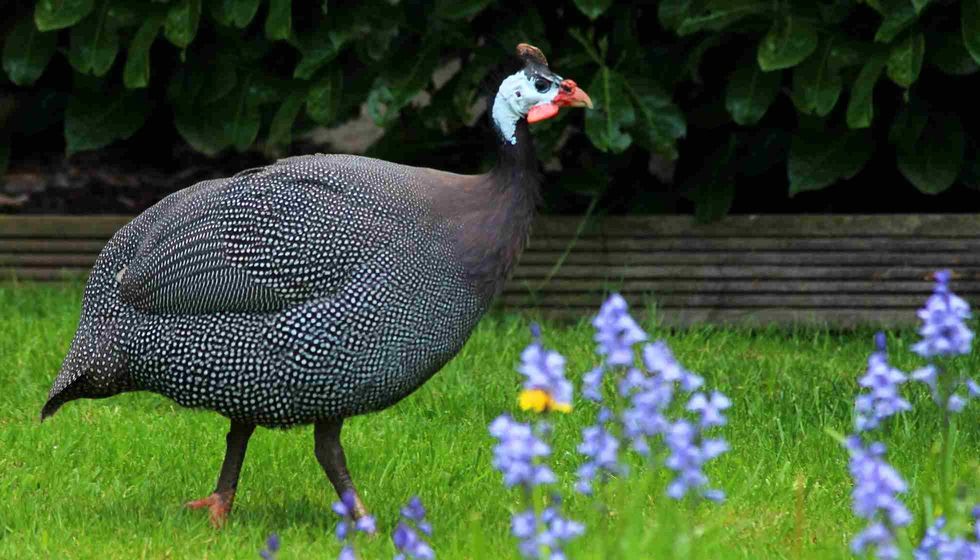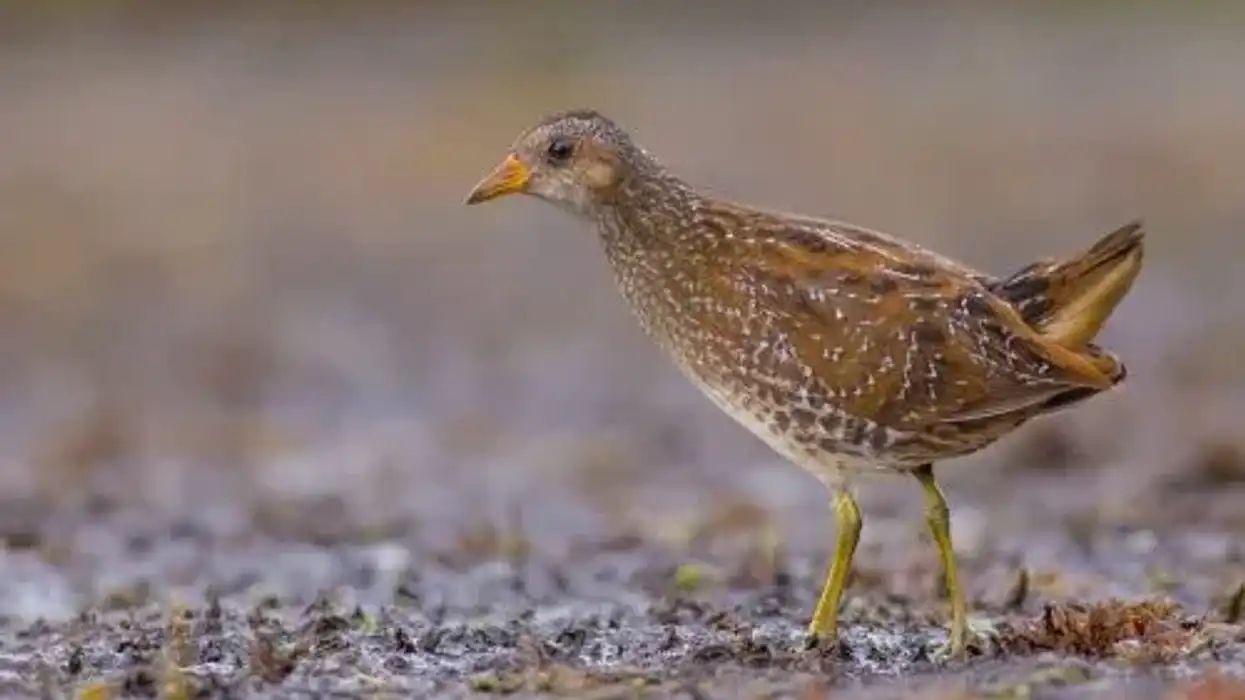Guinea fowl are birds of the family Numididae that live in Africa. And can be found in a range of six different species, with the helmeted guinea fowl being one of the most popular ones.
The helmeted species have been domesticated by humans and live in farms all around the world. Guinea fowl are chicken-like birds with and have featherless heads and necks.
These birds live in all different habitats around Africa. Most species live in grasslands or savanna, while some live in semiarid areas. Guinea fowl are omnivores and are social birds and live in flocks foraging for food together.
Although wild guinea fowl are good flyers, they spend most of their time on the ground. They are also known to be monogamous or serially monogamous.
Guinea fowl are ground-nesting birds which means they lay their eggs in ground nests. They are primarily domesticated as a food source, but they are also useful in hunting and eating pests that destroy crops on farms. So, for more information, read on for more fun facts and strange facts about guinea fowl!
For fun facts about other animals, take a look at hornbills and tawny owls.
Guinea Fowl Interesting Facts
What type of animal is a guinea fowl?
Guinea fowl are birds belonging to the order of Galliformes, which include other birds like turkey, chicken, pheasant, and quail. Guineas are poultry animals.
They have a short, stout bill with rounded wings, large toes, and powerful claws.
What class of animal does a guinea fowl belong to?
Guinea fowl belong to the Aves class of animals. Aves class compromises the birds' species. These birds are bipedal, feathered, and endothermic egg-laying animals. Birds are found worldwide, and their size can range from 1.96 in (5 cm) (bee hummingbird) to 108.26 in (275 cm) (ostrich).
Birds make up the largest number of species on earth, and there are about 10,000 bird species that occupy all available habitats on earth.
How many guinea fowls are there in the world?
The exact count of the number of guinea fowls found in the world is hard to pinpoint. But it's believed that there are at least 10,000 vulturine guineas (biggest species of guinea fowl) left in the wild.
Where do guinea fowl live?
Guinea fowl are found all across Africa; they mainly live in the sub-Saharan regions, some of them can be found in the entire sub-Saharan region.
Guinea fowls prefer to live in semiopen habitats like savanna or semideserts, while the species of black guinea fowl inhabit forests, with some perching high on treetops.
They now make up a great group of domesticated and wild birds. Today, these birds are raised on farms around the world for their meat and eggs, much like chickens.
What is a guinea fowl's habitat?
Guinea fowls are quick to adapt to their surroundings and can occur in different habitats all across Africa. Different species live in different habitats, which can range from grasslands, savannas to semiarid regions.
Some species only live in forests or heavily forested regions, while several species share habitats and ranges. Six species of this animal can be found primarily to the south of the Sahara Desert. However, they have been artificial introductions to different regions of the world by humans.
Who do guinea fowls live with?
Guinea fowl are creatures that exist in packs by nature and will feel isolated if they are alone. They live in flocks and like company and might get stressed out when they can't find other guineas around them to live with.
In cases of being raised on a farm, they can co-exist with other farm animals like chickens.
How long does a guinea fowl live?
The average lifespan of guinea fowls is around 10-15 years. Pesticides, diseases, loss of suitable habitat, poaching, especially in Africa, and low food resources might play a role in the life expectancy of this animal.
How do they reproduce?
The helmeted guinea fowl, the most closely studied and well-understood species of the bird, forms a close monogamous bond with a single mate over its lifetime. Their nest can contain up to 20 eggs in one batch, with an incubation period of 26-28 days. These nests are actually communal in nature and can contain eggs of multiple pairs.
Unlike the chicken, they are guided by seasons and the climate and do not lay eggs in extreme hot or cold weather, favoring the spring and summer, mostly after the annual height of rainfall, which leaves an abundance of resources.
After their first batch of eggs, they take a break and lay eggs again; they lay eggs four times a year.
And just like the chicken, they can lay eggs without the need for a male guinea.
What is their conservation status?
As of now, guineas are classified as a species of Least Concern by the IUCN Red List (International Union For Conservation Of Nature) because of their extensive range and abundance. The only exception being the white-breasted guinea fowl which is vulnerable to extinction.
Since these birds are adaptive to several habitats and circumstances, from plains to forest, they can exist without many problems, excluding predators who go for the nest and then them. Human intervention in the wild actually helps them as humans hunt and eliminate larger predators that may prey on guinea fowls.
Domestication of the helmeted guinea fowl (Numida meleagris) has also helped in better preservation and conservation of these birds in the wild since we use the domesticated ones for meat and egg.
Guinea Fowl Fun Facts
What do guinea fowls look like?

The seed and insect-eating guinea fowls have a featherless head. And can range in multiple colors and patterns depending on the subspecies they belong to. They have big curved bodies with short beaks and long necks. Their heads are usually covered with a combination of red, blue, tan, or brown color.
Most species of guineas have a blackish or grey plumage accompanied by dense white spots. The Plumed guinea fowl and the Crested guinea fowl have a distinctive black crest, and vulturine guinea fowls have a brown patch on the nape.
White-breasted guinea fowl and black guinea fowl are not well known, so a proper description is hard to find.
How cute are they?
Guinea fowl babies are the definition of cuteness! But adults not so much, as they look weird with their featherless heads and droopy wattles. And sadly, the fact that guineas aren't the brightest of animals doesn't help them in gaining cuteness points!
How do they communicate?
Guinea fowl sounds are divided into three categories! The basic form of communication is a sweet and gentle chirping sound.
The second form of communication is the one where hens make a buckwheat sound which is translated as them wanting attention. Males are quiet in comparison to females and content with just chirping.
The final form of communication is as loud as noises can get! These calls are similar to a siren and are used mainly to issue warnings.
How big is a guinea fowl?
Vulturine guinea fowls are the largest and prettiest species of the guineas, native to eastern Africa. They can grow from 24.01 in - 27.95 in (61 cm – 71 cm), with the Black guinea fowl being the smallest of the species standing at about 16.53 in (42 cm) in length.
How fast can a guinea fowl fly?
Guineas learn to fly at a very young age and are strong fliers that can reach 133.33 yd - 166.66 yd easily at a time. Guineas are also excellent at running and mostly prefer to move on foot in cases like running away from predators.
How much does a guinea fowl weigh?
Guineas are small avians and are not too much bigger than domestic chickens.
The largest species of the guinea fowl, the Vulturine guinea fowl, can weigh anywhere from 2.2 lb - 3.5 lb (1 kg - 1.6 kg), and the lightest are the black guinea fowl that can weigh from a mere 24.69 oz (700g) and can reach up to 3.5 lb (1.6kg).
What are their male and female names of the species?
Male guineas are called cocks, and females are called hens.
What would you call a baby guinea fowl?
A baby guinea fowl is called a keet.
Male guineas under one year of age are called guinea cockerel, and female guineas under the age of one year are called guinea pullet.
What do they eat?
Guinea fowl is an omnivore, meaning they it eats animal and plant. Their diet mainly consists of insects, rodents, reptiles, roots, and fruits. The helmeted guinea fowl is known for its humongous appetite hence, making great pest killers in domestic surroundings.
Are they dangerous?
No. These creatures are harmless. They are a nuisance to care for, though! But don't come anywhere near to being dangerous.
Would they make a good pet?
Guineas are excellent pets! They are nature's pest control and are a welcome addition to any farm and other domestic habitats. They eat insects, are low maintenance, and are great foragers.
Did you know...
Guineas are goofy animals and to watch them act and run around is free entertainment!
A flock of guineas who have sensed a predator can be so loud that their noises are almost deafening!
Guineas don't have a sense of boundaries and will run off in search of food!
Guineas are crazy fast! They usually run at a max speed of around 22 mph!
Guineas are low maintenance as their diet mainly comprises small annoying harmful pests. A flock of guinea can actually kill a snake!
The helmeted guinea fowl (Numida meleagris) is the species that has been domesticated and is the best known of the guinea fowl species.
The guinea fowl's eggs
Guinea fowl eggs are more nutritional in comparison to eggs from chickens. They are rich in protein, fat and are a great source of vitamin A!
But to get to the eggs, you have to work hard! Guinea hens will make you hunt for their eggs as they hide them. They also do this in order to stealthily hatch their eggs.
Keeping guinea fowls
Flocks of guineas will kill and eat small rodents, and in addition to that, they are used to contain the spread of insects on a farm. They can forage through a large number of insects without harming the vegetation.
They are also a great source of controlling wood ticks and deer ticks, the latter carrying Lyme disease. Flocks of guineas are also known to be able to kill snakes.
In addition to being nature's pest control, they are also great at making the presence of predators known with their loud noises and make the other farm take notice and hide.
Here at Kidadl, we have carefully created lots of interesting family-friendly animal facts for everyone to discover! Learn more about some other birds including nightingales and frigates.
You can even occupy yourself at home by drawing one on our guinea fowls coloring pages.









